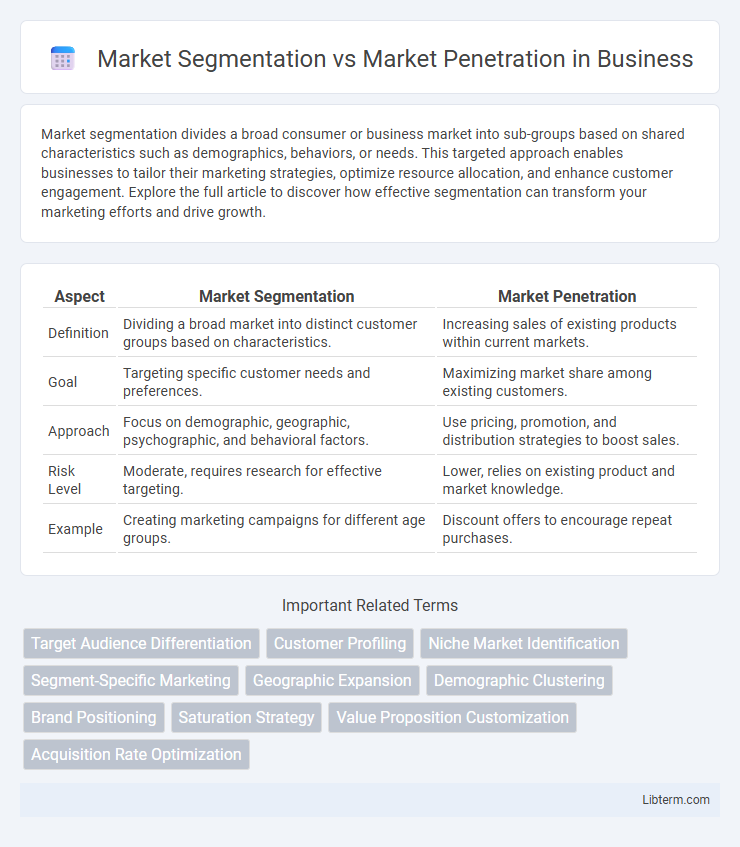Market segmentation divides a broad consumer or business market into sub-groups based on shared characteristics such as demographics, behaviors, or needs. This targeted approach enables businesses to tailor their marketing strategies, optimize resource allocation, and enhance customer engagement. Explore the full article to discover how effective segmentation can transform your marketing efforts and drive growth.
Table of Comparison
| Aspect | Market Segmentation | Market Penetration |
|---|---|---|
| Definition | Dividing a broad market into distinct customer groups based on characteristics. | Increasing sales of existing products within current markets. |
| Goal | Targeting specific customer needs and preferences. | Maximizing market share among existing customers. |
| Approach | Focus on demographic, geographic, psychographic, and behavioral factors. | Use pricing, promotion, and distribution strategies to boost sales. |
| Risk Level | Moderate, requires research for effective targeting. | Lower, relies on existing product and market knowledge. |
| Example | Creating marketing campaigns for different age groups. | Discount offers to encourage repeat purchases. |
Introduction to Market Segmentation and Market Penetration
Market segmentation divides a broad consumer or business market into sub-groups based on shared characteristics such as demographics, behavior, or needs, improving targeted marketing efforts. Market penetration measures the extent to which a product or service gains market share within an existing market, reflecting sales growth and competitive positioning. Both strategies play crucial roles in optimizing marketing effectiveness and driving business growth by either refining target audiences or increasing product usage among current customers.
Defining Market Segmentation
Market segmentation involves dividing a broad consumer or business market into sub-groups based on shared characteristics such as demographics, psychographics, geographic location, or behavioral traits. This process enables businesses to tailor their marketing strategies and product offerings to meet the specific needs and preferences of each segment, enhancing targeting precision. Unlike market penetration, which focuses on increasing sales within an existing market, segmentation aims to identify distinct customer groups for more effective resource allocation and personalized marketing efforts.
Understanding Market Penetration
Market penetration measures the extent to which a product or service is adopted by customers within a target market, reflecting sales volume relative to the total market potential. It emphasizes increasing market share by attracting new customers or encouraging existing customers to buy more frequently. Effective market penetration strategies include competitive pricing, aggressive promotions, and enhancing product accessibility to maximize customer acquisition and retention.
Key Differences Between Market Segmentation and Market Penetration
Market segmentation involves dividing a broad consumer or business market into sub-groups based on shared characteristics such as demographics, behaviors, or needs, allowing businesses to tailor their products or marketing efforts. Market penetration refers to strategies aimed at increasing sales of existing products within an existing market, focusing on gaining a larger market share through pricing, promotion, or increased distribution. The key difference lies in segmentation's emphasis on identifying and targeting distinct customer groups, whereas penetration focuses on deepening market presence and boosting sales among current customers.
Importance of Market Segmentation in Business Strategy
Market segmentation enables businesses to identify distinct customer groups based on demographics, behaviors, and preferences, allowing for tailored marketing strategies that increase relevance and engagement. Effective segmentation improves resource allocation by targeting high-potential segments, leading to increased conversion rates and customer loyalty. Integrating market segmentation into business strategy enhances competitive advantage and drives sustainable growth by meeting specific market needs more precisely than broad market penetration approaches.
Role of Market Penetration in Business Growth
Market penetration plays a critical role in business growth by increasing the market share of existing products within current markets through competitive pricing, promotional strategies, and enhanced distribution channels. Unlike market segmentation, which identifies specific customer groups to tailor marketing efforts, market penetration focuses on maximizing sales volume and revenue from the existing target audience. High market penetration drives customer loyalty, boosts brand visibility, and establishes a stronger competitive position, directly contributing to sustainable business expansion.
Advantages and Disadvantages of Market Segmentation
Market segmentation enables businesses to target specific customer groups with tailored marketing strategies, increasing the relevance and effectiveness of campaigns while potentially boosting customer loyalty and satisfaction. However, it can lead to higher marketing costs due to the need for specialized content and market research, and risks oversimplifying diverse customer needs within segments. While market segmentation improves targeting precision, it may limit overall market reach compared to broader strategies like market penetration.
Pros and Cons of Market Penetration
Market penetration focuses on increasing sales of existing products within current markets, offering advantages such as lower costs compared to product development and the ability to quickly gain market share. However, market penetration faces limitations including market saturation risks, intense competition, and the potential for diminishing returns as it relies on existing demand. Businesses must balance aggressive promotional efforts with maintaining product quality to avoid customer fatigue and brand dilution.
When to Use Market Segmentation vs Market Penetration
Market segmentation should be used when targeting diverse customer groups with distinct needs, preferences, or behaviors to create tailored marketing strategies. Market penetration is appropriate when the goal is to increase market share within an existing market by encouraging current customers to buy more or attracting competitors' customers. Choosing between market segmentation and market penetration depends on whether the focus is on identifying new customer segments or deepening engagement with the existing market.
Conclusion: Choosing the Right Strategy for Your Business
Evaluating your business goals, target audience, and competitive landscape is crucial when choosing between market segmentation and market penetration strategies. Market segmentation allows for tailored marketing efforts to distinct customer groups, enhancing relevance and customer satisfaction. Market penetration focuses on increasing market share within existing segments, often through price adjustments and promotional activities, making it ideal for businesses aiming for rapid growth in a familiar market.
Market Segmentation Infographic

 libterm.com
libterm.com